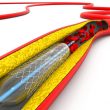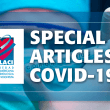Age may impact results when making an angioplasty choice based on fractional flow reserve (FFR) vs. instantaneous wave-free ratio (iFR). After 2 years of follow-up, patients whose treatment of intermediate lesions was deferred based on functional testing had similar outcomes regardless of whether this decision was informed by FFR or iFR. However, iFR performance was constant,<a href="https://solaci.org/en/2020/07/09/europcr-2020-deferral-based-on-ifr-vs-ffr-are-they-equivalent-or-is-there-a-new-gold-standard/" title="Read more" >...</a>
Stenting of Lipid-Rich vs Fibrous and calcified Plaques: Different Prognosis?
Coronary PCI with contemporary drug eluting stents (DES) in lipidic-rich plaques were not associated with increased periprocedural events at long term compared against plaques with no significant lipidic composition. This study recently published in J Am Coll Cardiol looked into the association between lipidic rich plaques detected by near-infrared spectroscopy (NIRS) and clinical events in<a href="https://solaci.org/en/2020/06/24/stenting-of-lipid-rich-vs-fibrous-and-calcified-plaques-different-prognosis/" title="Read more" >...</a>
SOLACI Peripheral | Clinical Case Discussion
SOLACI’s Department of Peripheral Endovascular Interventions is promoting the analysis of challenging clinical cases on peripheral interventions so as to foster the participation and engagement of all SOLACI members. In this first issue, we present a clinical case around carotid artery stenting. Read thoroughly the case below and take part in an unrestricted discussion through<a href="https://solaci.org/en/2020/06/17/solaci-peripheral-clinical-case-discussion/" title="Read more" >...</a>
Compare-Acute Sub-Study: Natural History of Non-Culprit Lesions in MI
The aim of this study was to determine the prognostic value of fractional flow reserve (FFR) of non-culprit lesions in STEMI patients. We analyzed data of all Compare-Acute patients (Comparison Between FFR Guided Revascularization Versus Conventional Strategy in Acute STEMI Patients With MVD) after PCI, from lesions assessed with FFR and treated medically. The treating<a href="https://solaci.org/en/2020/06/16/compare-acute-sub-study-natural-history-of-non-culprit-lesions-in-mi/" title="Read more" >...</a>
Bleeding and Cardiogenic Shock: An “Unholy Alliance”?
Courtesy of Dr. Carlos Fava. Mortality in acute myocardial infarction (MI) with cardiogenic shock (CS) has been reduced over the past two decades. This has been possible thanks to early angioplasty, greater operator (and overall medical team) experience, new antiplatelet therapies, and ventricular assist devices, which have also been somewhat relevant in this setting. However, in<a href="https://solaci.org/en/2020/06/12/bleeding-and-cardiogenic-shock-an-unholy-alliance/" title="Read more" >...</a>
Special Articles on COVID-19
Myocardial Injury for COVID-19 Even in Young Patients with Mild Symptoms Most young COVID-19 patients not requiring hospitalization showed abnormal cardiac magnetic resonance imaging (CMR) beyond two months after diagnosis. Read more HERE Infarction, Stroke and Aortic Emergency Syndromes in the Shadow of the Pandemic The coronavirus pandemic has had a negative impact on the<a href="https://solaci.org/en/2020/06/08/special-articles-on-covid-19/" title="Read more" >...</a>
The Most Read Scientific Articles of May in Interventional Cardiology
01- Management of Infarction During the COVID-19 Pandemic Patients with cardiovascular disease infected with COVID-19 are at a particular risk for morbidity and mortality. In any case, it should be noted that most patients requiring cardiovascular care due to ischemic heart disease, peripheral vascular disease, or structural heart disease are not infected. Read more HERE<a href="https://solaci.org/en/2020/06/03/the-most-read-scientific-articles-of-may-in-interventional-cardiology/" title="Read more" >...</a>
Temporary Emergency Guidelines for Infarction During the Pandemic
Several United States societies (the American Heart Association [AHA] among them) have answered the question of many physicians in the front lines: what is the ideal strategy for the treatment of ST segment elevation myocardial infarction (STEMI) during the COVID-19 pandemic? This document intends to ensure that patients with STEMI continue to receive adequate, proven<a href="https://solaci.org/en/2020/06/03/temporary-emergency-guidelines-for-infarction-during-the-pandemic/" title="Read more" >...</a>
Cardiovascular Sequelae Associated with COVID-19
Myocardial injury, as defined by an increased troponin level, can occur due to both ischemic and nonischemic processes. Myocarditis would be an example of a nonischemic event. A severe, acute respiratory infection causing hypoxia, especially due to COVID-19, can cause this myocardial injury. Elevated troponin levels have been described in patients infected with COVID-19, with<a href="https://solaci.org/en/2020/05/20/cardiovascular-sequelae-associated-with-covid-19/" title="Read more" >...</a>








